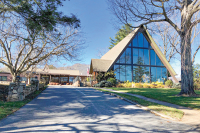Turning the tables: David Tripp’s artistic vision evolves with his craft
By Sarah Kucharski • Staff Writer
David Tripp’s workshop is piled head-high with wood. There are tree limbs here, locust logs there, stands of chestnut boards leaned against the wall and lying on the floor.
Under each table is a cache of scraps too good to throw away, and out back there are stacks upon stacks of wood just waiting for artistic inspiration to strike and Tripp to find their calling.
This is how he works — amidst a sort of organized chaos that defines his downtown Franklin workshop and retail store, The Table Co. He knows his inventory. Remembers individual boards, their curve and grain, and goes to them when a project fits.
“My palette is all around me, everywhere I see,” Tripp said.
The wood has been reclaimed from about 10 old barns throughout the region. Beginning to use aged, worn wood was a near total shift in artistic mediums for Tripp, whose furniture-building career originated in contemporary design. Tripp was raised in upstate New York. He followed his artist brother, Greg, to Florida in 1979 and the two were motivated by a photo in Sunset magazine to start their own furniture company.
At the time, the design work fell to Tripp’s brother, who had experience working with a variety of mediums from fiberglass to auto bodies. Tripp took over the business end.
“I didn’t even know what a router was,” he said.
However, Tripp slowly learned the needed skills and pushed Tripp Design Works to bring projects to fruition.
“I was always hands on,” Tripp said. “But as we got a crew of four or five, they didn’t like me coming in and working on their projects after they were gone.”
The company created high-end office furniture incorporating solid wood, metals and colored veneers influenced by the Memphis movement — a Milan-based collective of young furniture and product designers led by the veteran Ettore Sottsass. After its 1981 debut, Memphis dominated the early 1980s design scene with its post-modernist style.
Following his father’s death, Tripp took stock of his own life and in 1996 was on his own working full-time on his own line. He moved to Franklin in 1998 and went to work for someone else, but within a year ran into someone who needed a barn torn down. He’d found a leftover piece of chestnut outside one of the workshops he rented, milled it down and was drawn in by its beautiful imperfections. The wood broke him out of the slick, perfectly smooth design he was doing.
“I was a perfectionist before, and I was very detail-oriented,” Tripp said.
Rustic furniture’s hand-hewn beams, weathered, cut boards and exposed bark details are often rough to the touch. But Tripp applied his old finishing techniques to his new medium of reclaimed wood, retaining the wood’s character but making it more comfortable to use.
“People love to rub my finishes,” Tripp said.
Tripp now does mostly custom work. His showroom is filled with tables and mirrors that aim to showcase what he’s capable of and allow customers to see different types of styles and materials so that they can mix and match to their liking. It helps customers realize that they can get exactly what they want without having to compromise.
The work keeps Tripp busy. So while business is good, it leaves him little time to work on new and one-of-a-kind projects and his next artistic leap — combining rustic woods with contemporary design.





